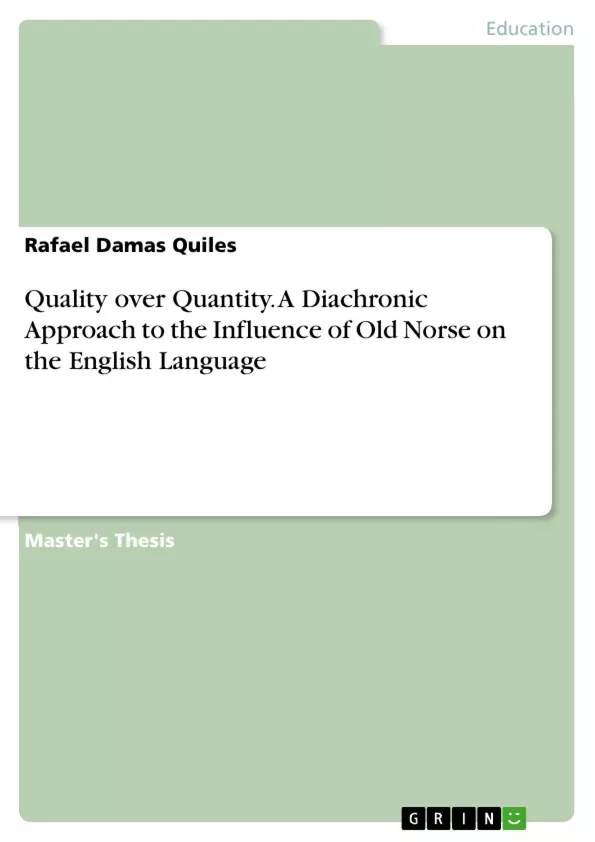This dissertation aims at explaining the enormous impact of Old Norse on the English language, more prominent in quality than in quantity. Such influence is firstly dealt with by focusing on the historical and sociocultural context, which, split into different periods, becomes of paramount importance in order to grasp the essence of such contact, both linguistic and cultural, between both societies throughout the centuries. Linguistically, general features of the Germanic group of languages are approached from different perspectives, mainly from the phonetical and morphosyntactic ones. Likewise, such analysis is followed by a comparative one between Old Norse and Old English as coexisting languages, thus allowing similarities and differences between both of them to come to the fore. Finally, the Old Norse influence is covered by taking into special account morphosyntactic and lexical elements, that is, those areas where both Germanic languages have come closer to each other. Therefore, this has allowed us to delve into those numerous items stemming either from the same or from dissimilar sources, most of which, whatever the case, are still substantially present in the everyday uses of today’s English.
Inhaltsverzeichnis (Table of Contents)
- INTRODUCTION AND TOPIC DESCRIPTION
- Nature of the research
- Background
- Objectives
- Relevance
- Hypothesis
- Operational definitions
- Cognates
- Danelaw
- Grimm's Law
- Intercomprehension
- Interculturality
- Metathesis
- Rhotacism
- Umlaut
- Verner's Law
- LITERATURE REVIEW
- Historical, social and cultural contact
- First period (787-850)
- Second period (850-878)
- Third period (878-1042)
- The Germanic group of languages
- Phonology
- Morphology
- Old English and Old Norse: a comparative analysis
- Phonology
- Morphology
- Historical, social and cultural contact
- THE INFLUENCE OF OLD NORSE ON MODERN ENGLISH
- Intercomprehension and interculturality
- Linguistic borrowings
- Morphology
- Grammar
- Vocabulary
- DISCUSSION
- Results
- Implications
- Limitations of the study
- Lines for future research
Zielsetzung und Themenschwerpunkte (Objectives and Key Themes)
This dissertation aims to explain the significant impact of Old Norse on the English language, focusing on its qualitative rather than quantitative influence. It examines this influence by first exploring the historical and sociocultural context, divided into distinct periods, which is crucial for understanding the linguistic and cultural contact between these societies throughout history. Linguistically, the dissertation investigates general features of the Germanic group of languages from phonological and morphosyntactic perspectives. A comparative analysis of Old Norse and Old English as coexisting languages follows, highlighting similarities and differences between them. Finally, the study delves into the specific areas of morphosyntax and vocabulary where Old Norse influence on English is most evident.
- The historical and sociocultural context of the contact between Old Norse and Old English.
- The linguistic features of the Germanic group of languages, particularly phonology and morphosyntax.
- A comparative analysis of Old Norse and Old English, exploring similarities and differences between these languages.
- The influence of Old Norse on English, with a focus on morphosyntactic and lexical elements.
- The impact of Old Norse on Modern English vocabulary and grammar.
Zusammenfassung der Kapitel (Chapter Summaries)
The first chapter, "Introduction and Topic Description," sets the stage for the dissertation. It introduces the research topic, its relevance, and its objectives, along with key operational definitions. The second chapter, "Literature Review," provides a comprehensive historical, social, and cultural background to the contact between Old Norse and Old English, detailing the three main periods of contact. It also delves into the general characteristics of the Germanic group of languages, specifically focusing on phonology and morphology. This chapter concludes with a comparative analysis of Old Norse and Old English, examining similarities and differences in their phonology and morphology. The third chapter, "The Influence of Old Norse on Modern English," explores the impact of Old Norse on the development of Modern English. It highlights the concepts of intercomprehension and interculturality and then examines linguistic borrowings, specifically focusing on their effects on morphology, grammar, and vocabulary.
Schlüsselwörter (Keywords)
This dissertation centers on the significant influence of Old Norse on the English language, focusing on its qualitative impact. It explores the historical and sociocultural context of this linguistic contact, investigates general features of the Germanic group of languages, and conducts a comparative analysis of Old Norse and Old English. The primary areas of investigation include the impact of Old Norse on the morphosyntax and vocabulary of English, with particular emphasis on the development of Modern English.
Key terms include: cognates, contact, influence, Modern English, intercomprehension, interculturality, loanwords, Old Norse, Scandinavian, stem.
- Quote paper
- Rafael Damas Quiles (Author), 2017, Quality over Quantity. A Diachronic Approach to the Influence of Old Norse on the English Language, Munich, GRIN Verlag, https://www.grin.com/document/416100



